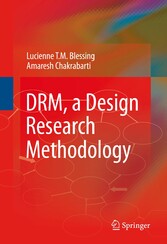Search and Find
Service
Preface
5
Contents
10
1 Introduction
17
1.1 Design
17
1.2 Design Research
18
1.3 Main Issues
22
1.4 Need for a Design Research Methodology
25
1.5 Objectives
26
1.6 Structure of this Book
27
1.7 Main Points
28
2 DRM: A Design Research Methodology
29
2.1 Introduction
29
2.2 Methodological Framework
30
2.3 Types of Research Within the DRM Framework
34
2.4 Representing Existing and Desired Situations
35
2.5 Success Criteria and Measurable Success Criteria
42
2.6 The Main Stages
45
2.7 Comparison with Other Methodologies
54
2.8 Main Points
57
3 Research Clarification
59
3.1 Research Clarification Process
60
3.2 Identifying Overall Topic of Interest
61
3.3 Clarifying Current Understanding and Expectations
67
3.4 Clarifying Criteria, Main Questions and Hypotheses
73
3.5 Selecting Type of Research
76
3.6 Determining Areas of Relevance and Contribution
79
3.7 Formulating Overall Research Plan
83
3.8 General Guidelines on Doing Research
86
3.9 Main Points
88
4 Descriptive Study I: Understanding Design
91
4.1 Schools of Thought
92
4.2 Types of DS-I
96
4.3 DS-I Process Steps
96
4.4 Reviewing Literature
97
4.5 Determining Research Focus
105
4.6 Developing Research Plan for DS-I
118
4.7 Undertaking an Empirical Study
130
4.8 Drawing Overall Conclusions
147
4.9 Main Points
153
5 Prescriptive Study: Developing Design Support
157
5.1 Types of Design Support
158
5.2 Types of PS
159
5.3 A Systematic PS Process
160
5.4 Task Clarification
164
5.5 Conceptualisation
169
5.6 Elaboration
180
5.7 Realisation
183
5.8 Support Evaluation
192
5.9 Main Points
194
6 Descriptive Study II: Evaluating Design Support
197
6.1 Evaluation
198
6.2 Types of DS-II
211
6.3 Systematic DS-II Process
212
6.4 Reviewing Existing Documentation
213
6.5 Determining Evaluation Focus
215
6.6 Developing Evaluation Plan(s)
217
6.7 Undertaking Evaluation
225
6.8 Drawing Overall Conclusions
227
6.9 Main Points
228
7 Writing Up: Publishing Results
231
7.1 Various Forms of Publication and Their Intent
232
7.2 Overall Structure of a Thesis
233
7.3 Approaches to Help Structure a Thesis
235
7.4 Tips on Writing Specific Sections
237
7.5 Writing Papers
243
7.6 General Guidelines
243
7.7 Main Points
245
8 Summary and Conclusions
247
8.1 Experience of Using DRM
247
8.2 Further Research
253
Appendix A Descriptive Study Methods
254
A.1 Paradigms and Assumptions
254
A.2 Reviewing Empirical Studies
258
A.3 Laboratory Versus Industrial Environment
269
A.4 Data-collection Methods
269
A.5 Statistical Analysis
288
Appendix B Prescriptive Study Methods
292
B.1 Product Development Methodologies
292
B.2 Software Development Approaches
297
B.3 User-interface Design
310
B.4 Support Outline: Summarising Scope and Assumptions
316
Appendix C Example Research Projects
320
C.1 Overview of the Examples
320
C.2 A Process-based Approach to Computer-supported Engineering Design
322
C.3 A Program for Computational Synthesis and Conceptual Design Support
333
C.4 Teamwork in Engineering Design
343
C.5 Measuring Conceptual Design Process Performance in Mechanical Engineering: A Question-based Approach
354
C.6 Design for Quality
366
C.7 Multi-disciplinary Design Problems
376
C.8 Design for Reliability in Mechanical Systems
386
References
397
Index
407
All prices incl. VAT













